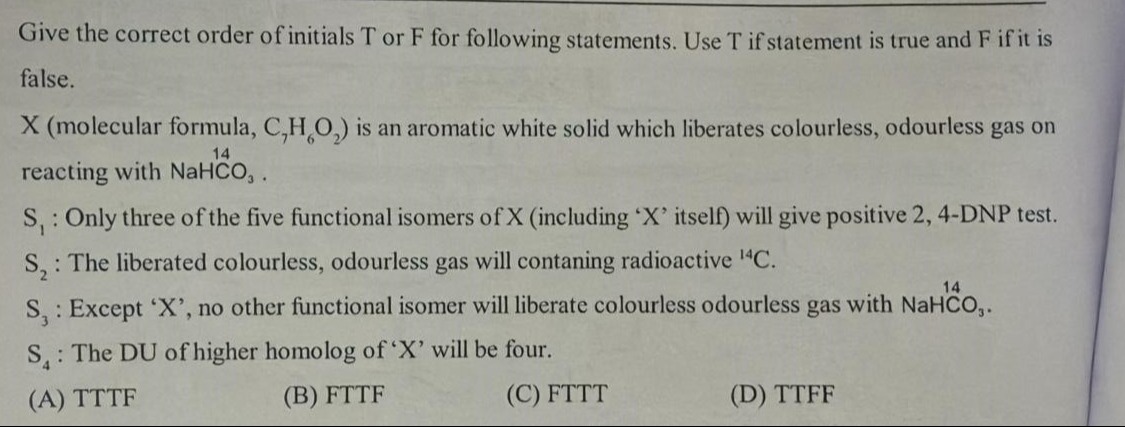Question
Question: Give the correct order of initials T or F for following statements. Use T if statement is true and F...
Give the correct order of initials T or F for following statements. Use T if statement is true and F if it is false.
X (molecular formula, C7H6O2) is an aromatic white solid which liberates colourless, odourless gas on reacting with NaH14CO3.
S1: Only three of the five functional isomers of X (including 'X' itself) will give positive 2, 4-DNP test.
S2: The liberated colourless, odourless gas will contaning radioactive 14C.
S3: Except 'X', no other functional isomer will liberate colourless odourless gas with NaH14CO3.
S4: The DU of higher homolog of 'X' will be four.

TTTF
FTTF
FTTT
TTFF
TTTF
Solution
The given molecule X has the molecular formula C7H6O2. It is an aromatic white solid that reacts with NaH14CO3 to liberate a colourless, odourless gas. The reaction with bicarbonate is characteristic of carboxylic acids, which are strong enough acids to react with weak bases like bicarbonate, producing CO2. The DU of C7H6O2 is (2×7+2−6)/2=(14+2−6)/2=10/2=5. An aromatic structure with DU=5 and formula C7H6O2 is likely benzoic acid (C6H5COOH). Benzoic acid is an aromatic white solid and its reaction with bicarbonate is C6H5COOH+NaHCO3→C6H5COONa+H2O+CO2. The gas is CO2, which is colourless and odourless. Thus, X is benzoic acid.
Now let's evaluate the statements:
S1: Only three of the five functional isomers of X (including 'X' itself) will give positive 2, 4-DNP test. The plausible aromatic functional isomers of C7H6O2 with DU=5 are:
- Benzoic acid (C6H5COOH): Carboxylic acid. Does not give a positive 2,4-DNP test. (This is X)
- Phenyl formate (HCOOC6H5): Ester. Does not give a positive 2,4-DNP test.
- o-Hydroxybenzaldehyde (o−HOC6H4CHO): Aldehyde + Phenol. Gives a positive 2,4-DNP test due to the aldehyde group.
- m-Hydroxybenzaldehyde (m−HOC6H4CHO): Aldehyde + Phenol. Gives a positive 2,4-DNP test due to the aldehyde group.
- p-Hydroxybenzaldehyde (p−HOC6H4CHO): Aldehyde + Phenol. Gives a positive 2,4-DNP test due to the aldehyde group. These are 5 functional isomers. Out of these, the three hydroxybenzaldehyde isomers give a positive 2,4-DNP test. So, statement S1 is true.
S2: The liberated colourless, odourless gas will contaning radioactive 14C. The reaction is C6H5COOH+NaH14CO3→C6H5COONa+H2O+14CO2. The carbon dioxide gas is formed from the bicarbonate ion, which is labeled with 14C. Therefore, the liberated CO2 will contain 14C. Statement S2 is true.
S3: Except 'X', no other functional isomer will liberate colourless odourless gas with NaH14CO3. Reaction with bicarbonate requires a sufficiently acidic compound, typically a carboxylic acid (pKa ~4-5) or a very strong phenol (like picric acid, pKa < 1). Phenols generally have pKa values around 10 and do not react with bicarbonate. Among the 5 isomers identified:
- Benzoic acid (X): Carboxylic acid, reacts with NaH14CO3.
- Phenyl formate: Ester, not acidic.
- o-, m-, p- Hydroxybenzaldehyde: Contain a phenolic -OH group. Phenols are not acidic enough to react with bicarbonate. Therefore, only X (benzoic acid) among these functional isomers will react with NaH14CO3 to liberate CO2. Statement S3 is true.
S4: The DU of higher homolog of 'X' will be four. X is benzoic acid (C6H5COOH). A higher homolog of an aromatic carboxylic acid would typically be a methylbenzoic acid (CH3C6H4COOH, e.g., toluic acid) or phenylacetic acid (C6H5CH2COOH). For CH3C6H4COOH (C8H8O2): DU = (2×8+2−8)/2=(16+2−8)/2=10/2=5. For C6H5CH2COOH (C8H8O2): DU = (2×8+2−8)/2=(16+2−8)/2=10/2=5. The DU of these higher homologs is 5 (4 for the benzene ring + 1 for the carboxyl C=O). Statement S4 is false.
The correct order of initials T or F for statements S1,S2,S3,S4 is TTTF.
Comparing this with the given options: (A) TTTF (B) FTTF (C) FTTT (D) TTFF
The correct option is (A).
